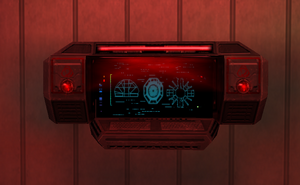
A Master Control Terminal
Master Control Terminals were an ingenious invention which entered widespread use in the First Tiberium War. While Nod and GDI were locked in mortal combat, both sides noticed that as the war dragged on, it became increasingly hard to staff bases with the proper personnel, let alone maintain them. With these difficulties becoming more and more prominent, technical R&D divisions of both sides hastily started development of a system that could not only monitor the status of a structure, but also run it without assistance. Their divisions soon reached a breakthrough, albeit one that required the violation of an unspoken engineering rule. Instead of using technology to augment human abilities, the design of the master control terminals required the adoption of the ideology that technology existed to eliminate the need for human oversight and, by extension, human error.
The Master Control Terminals soon exited its prototype stage and was approved for deployment in combat. Though the system still operated within the constraints of its programming, and as such could not be strictly considered artificial intelligence, it was still a highly sophisticated program capable of monitoring the structure's status and acting accordingly. With control over all of a structure's functions, it was capable of performing any duty within its line of work, even those as complex as Tiberium processing. The system also utilized various sensory and robotic repair facilities (and/or a human technician in some cases) to diagnose, plan and repair the building in an effective matter. At the system's heart was a highly advanced and miniaturized mainframe, embedded in a sturdy frame of a console, which also served as the control terminal for the system. The consoles were usually located in highly secure locations within the buildings and more often than not protected by sophisticated weapon systems and security personnel. Due to their appearance, they soon became known as Master Control Terminals.
The system performed its role flawlessly, and field commanders did not have to worry about maintenance staff - only a small crew was required to keep structures in operational shape, compared to the large number of labor required in the pre-MCT days.
The system had one main flaw, however - the console's sturdy frame, while resistant to indirect damage, was very weak when it came to explosives and direct fire. C4 charges could make short work of the control system and render the facility inoperable, as once the system was destroyed it had to be completely replaced. This process was extremely lengthy and could not hope to be done within a reasonable amount of time, so buildings whose MCTs were destroyed in combat were often considered lost for the rest of the battle. GDI Commando Nick "Havoc" Parker repeatedly exploited this vulnerability to deadly effect during the First Tiberium War, demolishing entire Nod complexes with a small handful of demolition charges by locating and blowing out their Master Control Terminals. Properly trained technical personnel were also capable of altering the MCT's "allegiance", so to speak, such that their operations contributed toward the engineer's commanding officer instead of who they previously served. Starting from the Second Tiberium War, EMP based weapons also possessed a large danger to these systems, and their short-circuiting abilities could cause substantial damage. Such weapons were capable of disabling even an entire base's MCTs, which effectively rendered the entire base offline and vulnerable to attack. Engineers have since redesigned the MCT to automatically reboot in the event of such a situation; however the reboot takes a few seconds to complete and the structure remains vulnerable during this time.
The design of the Master Control Terminals continued to see use throughout the Second Tiberium War and beyond. Since the human personnel that remained within structures did not need to have an excessive amount of technical knowledge to perform their minimal duties, they were often as well-trained in combat as their frontline counterparts. In this case, in the event of the building's destruction, these personnel could escape its wreckage and enter combat.
During the Third Tiberium War, Nod appeared to have a heightened wariness for EMP weapons (perhaps a fear born of GDI's newly developed EMP-based orbital slugs), and as such installed a backup system on their vehicles and structures to bring them online again in the event of an EMP attack. While the mechanics behind the remote reactivation of vehicles remained among Nod's many mysteries, their structures were presumably repaired via some sort of backup generator restoring power to their Master Control Terminals.
In-Game
Master Control Terminals only make a direct appearance in Command and Conquer: Renegade. The MCT must be located and destroyed in order to eliminate a building; they are otherwise immune to all sources of damage excluding that of GDI and Nod's respective superweapon beacons.
